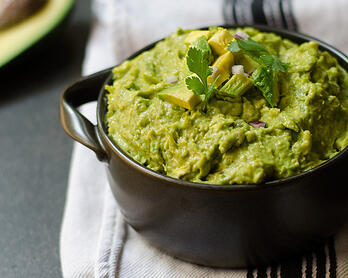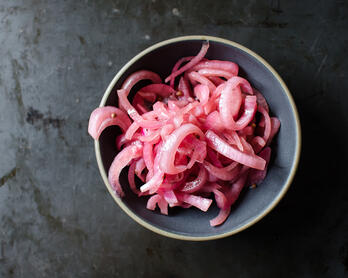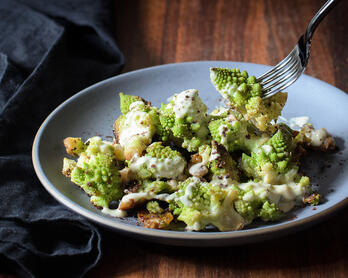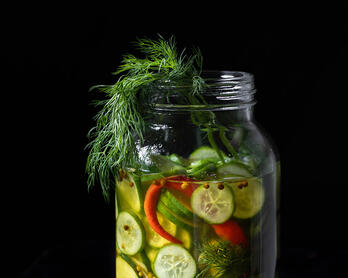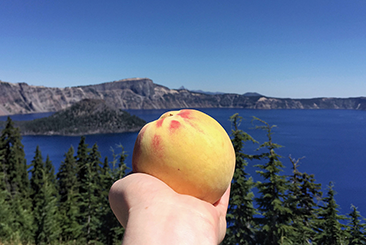How to Buy, Cook, and Reduce the Bitterness of Brussels Sprouts

I prefer the flavor of roasted or fried brussels sprouts over braised since the former are firm, caramelized, and nutty rather than bitter. I decided to ask The Google if there was some food science behind my preference. As it turns out, human genetics, crop breeding, and cooking technique all play a role in our palate's response to brussels sprouts. I pulled together some interesting useless facts for this post along with a simple roasting recipe.
Brussels sprouts are part of the Thanksgiving timeline as noted at the bottom of this post.
Useless Facts
Sprouts, The Next Generation
Over the last twenty years, farmers have mellowed the "unpleasant" flavor of brussels sprouts by breeding a vegetable that contains fewer bitter compounds or glucosinolates. So, brussels sprouts just taste better than they used to when we were kids. The rub is that glucosinolates help protect sprouts against pests. By improving the flavor, farmers are also lowering the plant's natural defenses.
I recall a farmer telling me that aesthetically perfect brussels sprouts "can't be 100% organic" since they're so prone to bugs. Next time I'm at the market, I plan to ask that farmer if the vulnerability is a result of the breeding/reduced glucosinolates. Or perhaps I misunderstood what he meant, I'm not sure yet. A long but informative article on the subject is here.
Genetic Predisposition
Some humans are genetically wired to dislike brussels sprouts more than others. There's a receptor on the tongue that responds to bitter compounds present in certain veggies, and for some people that receptor is very sensitive. In addition, the human brain has evolved to associate bitterness with poison which would explain why many people are instinctively turned off by that taste. An article on the subject is here. Another interesting article along the same lines discusses why some people don't enjoy cilantro. If you just can't get enough, here's some reading about people who are "supertasters".
And a quick tip for kids from cool Auntie Cynthia. If your parents put broccoli or brussels in front of you, the correct response should be, "Thank you, but I can't eat this. My TAS2R receptor is crazy sensitive." Or perhaps, "I can't eat this, I just have way too many taste buds." You're welcome.
Fast and Hot
In my opinion, frying brussels sprouts creates the best flavor while roasting comes in a close second. If you prolong the cooking process and/or overcook these little cabbages, they will chemically transform into sulphuric mush. The goal is to caramelize the outside while maintaining a firm and nutty interior. Also, keep in mind that carry-over cooking will continue to soften the veggies a bit once they've come out of the oven so plan accordingly.
Slice and Dice
The flavor components that contribute to a bitter flavor are concentrated in the center of the brussels sprout. If you slice the the veggie in half, it helps to release some of those compounds during the cooking process.
How to Buy
Smaller is better when it comes to tenderness and flavor. Look for brussels sprouts that:
- Are vibrant green in color.
- Are around 1 - 1 1/2 inches in diameter.
- Have a tight leaf structure.
- Are not yellowing or browning.
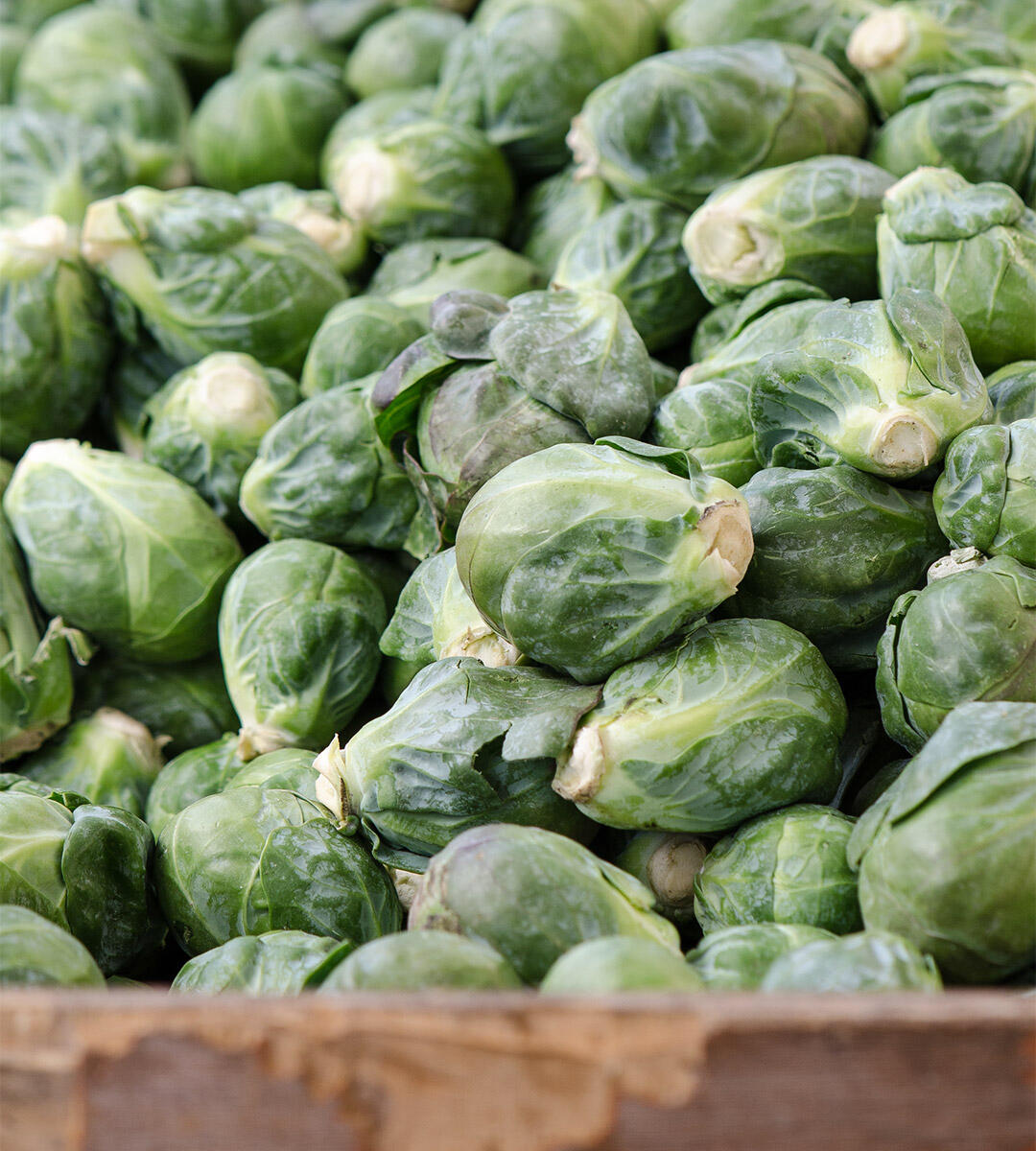
Brussels sprouts at Two Peas in a Pod - Santa Monica Farmers Market
Tools
The Lodge Combo Cooker is my go-to cast iron for searing and sourdough bread baking. It's a great price for the utility and caramelizes the brussels sprouts beautifully.
Ingredients
- 1 pound brussels sprouts
- Quality olive oil
- Flake-style salt and freshly ground pepper
- Parmigiano-Reggiano for grating (omit for vegan dishes)
Instructions
Prep
- Wash and dry.
- Remove one layer of outer leaves (this is a personal preference).
- Trim off the dirty/woody end of the root.
- Slice the sprouts in half lengthwise.
Roast
- Move your oven rack to the middle position and heat to 425.
- Line a baking sheet with foil and then lay a piece of parchment paper on top.
- Transfer the cut brussels sprouts to the baking sheet, drizzle generously with olive oil, and then gently toss so that the sprouts are coated evenly. Note: I like to toss the brussels sprouts on the baking sheet so that the parchment is also coated with oil.
- Arrange in a single layer with the cut side down, sprinkle with salt, and roast for 10-15 minutes.
- Check on the sprouts at 10 minutes to ensure that they're not getting too soft. As mentioned under "Fast and Hot", keep in mind that carry-over cooking will continue to soften the veggies a bit once they've come out of the oven.
- Once finished, add pepper and grated Parmigiano-Reggiano to taste and serve immediately.
UPDATE: I've found that searing brussels sprouts "hard" in a cast-iron skillet produces a fantastic result. Heat the skillet over medium-high, add 1 tablespoon of bacon fat or quality olive oil, then sear cut side down until well charred. Flip and continue to cook until desired texture is reached.
In summary, fry your veggies.
Thanksgiving Dinner Timeline (as it stands currently)
2 Weeks Ahead - Freeze the Following
- Honey Roasted Applesauce (for Cranberry Sauce)
- Melted Leeks
- Chicken Stock
- Roasted Garlic
1 Week Ahead
- Freeze cranberry sauce or make on Tuesday.
- Freeze freshly baked bread for stuffing.
Tuesday
- Refrigerate uncooked pumpkin pie dough.
- Roast the Chestnuts.
- Transfer all frozen ingredients to the refrigerator.
- Cover turkey in dry brine.
Wednesday
- Refrigerate uncooked stuffing.
- Bake and refrigerate pumpkin cheesecake.
- Bake pumpkin pie.
- Set the table.
Thanksgiving Day
- Peel potatoes and cover with water.
- Remove turkey 40 minutes ahead and rinse. Bake at 350°F.
- Make giblet stock - 2 hours.
- At about 120 degrees, make the Roasted Garlic Mashed Potatoes. Withhold 1/2 cup of half and half to add when reheating. Transfer mashed potatoes to a microwave-safe bowl, cover with plastic, clean pot.
- 40 minutes before turkey is done, remove stuffing, cranberry sauce, and veggies from refrigerator and prep gravy ingredients.
- When turkey comes out of the oven, chill and/or decant wine.
- While the turkey rests, bake stuffing at 400°F and make the gravy.
- 15 minutes before the stuffing is done, increase the oven temperature from 400 to 425°F and put the brussels sprouts in.
- Right before plating, reheat Roasted Garlic Mashed Potatoes in the microwave.
